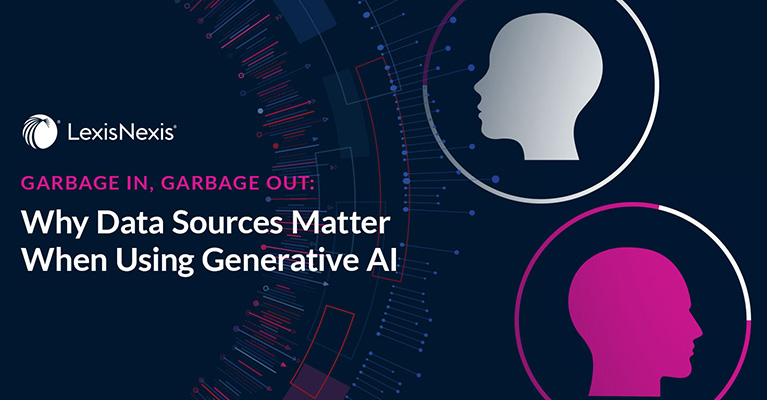Nearly 9/10 executives consider investing in AI and data to be a top priority for their company. But 8/10 of those initiatives are likely to end in failure. In this post, we explore the key reasons behind...
Large Language Models and generative AI tools have transformed the way organisations bring order to the vast amount of online and offline data available. AI can narrow down this data universe to a concise...
Artificial intelligence (AI) offers an incredible amount of opportunity from enhancing productivity to managing information. But, because AI "learns" from the data you give it, it's critical to develop...
In consulting, every opportunity starts with a market trigger, whether it be a change in leadership, a new industry regulation or an unexpected shift in investor sentiment. These trigger events can open...
See how Nexis+ AI and Nexis ® Data+ help management consultants power faster research, credible insights, and compliant AI innovation. As a management consultant, data is your competitive edge. Whether...

In a recent LinkedIn post, data and technology transformation consultant Tommy Tang writes, “Generative AI has emerged as a potent tool across various domains, from content creation to bolstering decision support systems.” He warns, however, that “The efficacy of generative AI is intrinsically tied to the quality of its training data.” And therein lies the challenge, aptly summarized by the adage, “Garbage in, garbage out.” For that reason alone, it pays to understand how any third-party data you use has been aggregated and enriched before you feed it into your generative AI (GenAI) applications.
The Domino Effect of Poor-Quality Data
As digital transformation and use of GenAI accelerates, the implications of low-quality data can turn the potential of GenAI from promising to perilous in an instant. From misguiding algorithms to yielding impractical results, choosing the wrong third-party data provider can lead to a cascade of unintended consequences.
- Perpetuating Biases: Poor quality data, especially data marred by inherent biases, gives GenAI a skewed perspective. Consequently, the AI may generate content that not only reinforces harmful biases but also alienates prospective customers and harms trust among stakeholders.
- Reputation Under Fire: When GenAI produces content that is inaccurate, biased, or otherwise misaligned with reality or societal norms, your organizations could wind up in the crosshairs of public scrutiny and reputational damage.
- Misinformation Proliferation: GenAI is currently devoid of discernment, making it easy to perpetuate misinformation, eroding trust in the technology and the organization using it. Giving GenAI access to a large corpus of quality data creates a broad foundation on which the AI can cross-reference and validate data, acting as a buffer against misinformation.
- Strategic Derailment: Misleading or incomplete data can cause the AI to generate insights or content that pushes strategic planning astray, fostering decisions that misalign with market realities and organizational goals.
- Impaired Customer Interactions: Lack of relevant and accurate data might lead the AI to produce content or responses that miss the mark in customer interactions, souring relationships, and diminishing user experience.
- Wasted Resources: Inaccurate or irrelevant data may misguide AI-powered automated processes, leading to misallocated resources, squandered opportunities, and ultimately financial losses.
- Inhibited Innovation: If the data GenAI ingests is not timely or relevant, the outputs will likewise present an inadequate picture of diverse and current trends, leading stagnation and a lack innovation that hampers your ability to stay competitive and forward-thinking.
Each of the above risks underscores the importance of selecting third-party data sources you intend to fuel GenAI. They should undergo robust vetting and ongoing monitoring to safeguard against these potential problems.
What to look for in third-party data
The journey from selecting to ingesting data is nuanced, demanding a meticulous understanding of what you need from the data. Navigating it requires you to verify that you source data that offers relevance, volume, and quality that aligns with your objectives for GenAI.
- Reliable, Global Sources: Ingesting data from a wide range of reputable sources helps safeguard the AI from internalizing and propagating errors or narrow perspectives.
- Abundant Volume: Vast pools of historical and current data to support backwards-looking as well as future-focused analysis.
- Enrichments to Enhance Useability: Facilitating smooth data ingestion and incisive insights extraction are pivotal in today’s data-abundant ecosystem. Topic tags, industry tags, sentiment and other metadata amplifies its usability and relevance.
By choosing an experienced data aggregator and provider, you get the volume, variety, and value you need from the third-party data you ingest.
Anchor trust by using proven third-party data providers
Aligning with a proficient third-party data provider pivots your GenAI towards a trajectory defined by accuracy, relevancy, and insightful data generation. Here, the credibility of a provider becomes paramount, especially one that not only brings to the table a profound depth and breadth in its data sources but also adheres to a rigorous process of crafting semi-structured, enriched data.
The caliber of GenAI is a direct reflection of the quality, volume, and variety of data it is nurtured on. Ensuring that the data you ingest is well-structured, enriched, and insightful paves the way towards unleashing the true potential of GenAI.